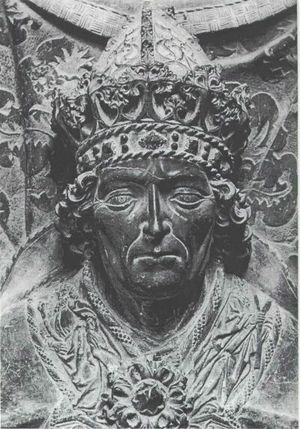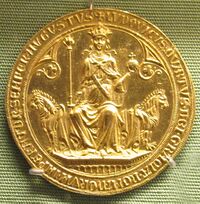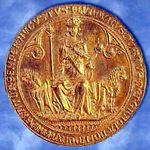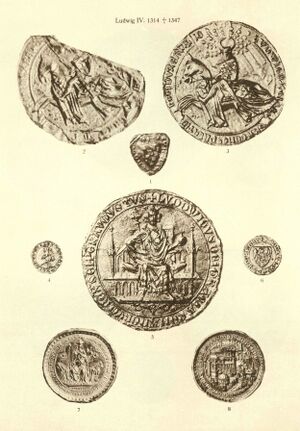لويس الرابع، الامبراطور الروماني المقدس
| لويس الرابع | |
|---|---|
| إمبراطور روماني مقدس؛ ملك الرومان، بورجوندي، وإيطاليا، دوق باڤاريا | |
 پورتريه لويس الرابع (على شاهد قبر قوطي متأخر مصنوع من الرخام الأحمر في 1468 من صنع هانز هالدنر)، القبر في فراونكيرشه من ميونخ | |
| ملك الرومان حتى 1330 مع فريدريك الوسيم | |
| العهد | 20 أكتوبر 1314 – 11 أكتوبر 1347 |
| التتويج | 25 نوفمبر 1314 (Aachen) |
| سبقه | هنري السابع |
| تبعه | تشارلز الرابع |
| ملك إيطاليا | |
| العهد | 31 مايو 1327 – 11 اكتوبر 1347 |
| التتويج | 31 مايو 1327 (ميلانو) |
| سبقه | هنري السابع |
| تبعه | تشارلز الرابع |
| الإمبراطور الروماني المقدس | |
| العهد | 1328 – 11 اكتوبر 1347 |
| التتويج | 17 يناير 1328 (روما) |
| سبقه | هنري السابع |
| تبعه | تشارلز الرابع |
| دوق باڤاريا until 1317 with رودولف الأول | |
| العهد | 1301 – 11 اكتوبر 1347 |
| سبقه | رودولف الأول |
| تبعه | Louis V the Brandenburger ستفن الثاني لويس السادس الروماني وليام الأول ألبرت الأول أوتو الخامس الباڤاري |
| وُلِد | ابريل، 1282 ميونيخ |
| توفي | 11 أكتوبر 1347 [aged 65] بوش قرب فورستنفلدبروك |
| الدفن | |
| الزوج | Beatrix of Świdnica (1308–1322) مارگريت من هولندا (1324–1347) |
| الأنجال | ماتيلدا من باڤاريا (1313–1346) Louis V the Brandenburger (1316–1361) ستفن الثاني (1319–1375) لويس السادس الروماني (1328–1365) ويليام الأول (1330–1389) ألبرت الأول (1336–1404) Beatrix of Bavaria (1344–1359) وتو الخامس الباڤاري (1346–1379) |
| البيت | سلالة ڤيتلسباگ |
| الأب | لويس الثاني من باڤاريا |
| الأم | ماتيلدا من هابسبورگ |
| الديانة | الكاثوليكية الرومانية |
لويس الرابع، الامبراطور الروماني المقدس Louis IV, Holy Roman Emperor (و. 1 أبريل 1282 – ت. 11 أكتوبر 1347)، (يعرف أيضا بلودڤيش الباڤاري) من سلالة ڤيتلسباگ (1 أبريل 1282 -- 11 أكتوبر 1347)، كان دوق باڤاريا في الفترة ما بين 1294-1301 إلى جانب شقيقه رودولف الأول، كما كان كونت بالاتينات حتى عام 1329، وملك ألمانيا منذ 1314 وتوج إمبراطورا للرومانية المقدسة في عام 1328. توفي لويس في 11 أكتوبر 1347 بتعرضه لسكتة دماغية أثناء اصطياد دببة في بوش قرب مدينة فورستنفلدبروك. ودفن في كنيسة فراونكيرشي بميونيخ.
ولودڤيگ هو لودڤيگ الثاني دوق باڤاريا العليا وكونت بالاتينات الراينية، وميشتيلد ابنة الملك رودولف الأول.
عهده المبكر كدوق لبافاريا العليا
Louis was born in Munich, the son of Louis II, Duke of Upper Bavaria and Count Palatine of the Rhine, and Matilda, a daughter of King Rudolph I.[1][2]
Though Louis was partly educated in Vienna and became co-regent of his brother Rudolf I in Upper Bavaria in 1301 with the support of his Habsburg mother and her brother, King Albert I, he quarreled with the Habsburgs from 1307 over possessions in Lower Bavaria. A civil war against his brother Rudolf due to new disputes on the partition of their lands was ended in 1313, when peace was made at Munich.
In the same year, on November 9, Louis defeated his Habsburg cousin Frederick the Fair who was further aided by duke Leopold I.[3] Originally, he was a friend of Frederick, with whom he had been raised. However, armed conflict arose when the guardianship over the young Dukes of Lower Bavaria (Henry XIV, Otto IV, and Henry XV) was entrusted to Frederick, even though the late Duke Otto III, the former King of Hungary, had chosen Louis. On 9 November 1313, Frederick was defeated by Louis in the Battle of Gammelsdorf and had to renounce the tutelage. This victory caused a stir within the Holy Roman Empire and increased the reputation of the Bavarian Duke.[4]
انتخابه كملك ألماني والصراع مع هابسبورگ
The death of Holy Roman Emperor Henry VII in August 1313 necessitated the election of a successor. Henry's son John, King of Bohemia since 1310, was considered by many prince-electors to be too young,[5] and by others to be already too powerful. One alternative was Frederick the Fair, the son of Henry's predecessor, Albert I, of the House of Habsburg. In reaction, the pro-Luxembourg party among the prince electors settled on Louis as its candidate to prevent Frederick's election.[6]
On 19 October 1314, Archbishop Henry II of Cologne chaired an assembly of four electors at Sachsenhausen, south of Frankfurt. Participants were Louis' brother, Rudolph I of the Palatinate, who objected to the election of his younger brother, Duke Rudolph I of Saxe-Wittenberg, and Henry of Carinthia, whom the Luxembourgs had deposed as King of Bohemia. These four electors chose Frederick as King.
The Luxembourg party did not accept this election and the next day a second election was held.[7] Upon the instigation of Peter of Aspelt, Archbishop of Mainz, five different electors convened at Frankfurt and elected Louis as King. These electors were Archbishop Peter himself, Archbishop Baldwin of Trier and King John of Bohemia – both of the House of Luxembourg – Margrave Waldemar of Brandenburg and Duke John II of Saxe-Lauenburg, who contested Rudolph of Wittenberg's claim to the electoral vote.
This double election was quickly followed by two coronations: Louis was crowned at Aachen – the customary site of coronations – by Archbishop Peter of Mainz, while the Archbishop of Cologne, who by custom had the right to crown the new king, crowned Frederick at Bonn. In the following conflict between the kings, Louis recognized in 1316 the independence of Switzerland from the Habsburg dynasty.[4]
After several years of bloody war, victory finally seemed within the grasp of Frederick, who was strongly supported by his brother Leopold. However, Frederick's army was decisively defeated in the Battle of Mühldorf[8] on 28 September 1322 on the Ampfing Heath, where Frederick and 1300 nobles from Austria and Salzburg were captured.
Louis held Frederick captive in Trausnitz Castle (Schwandorf) for three years, but the determined resistance by Frederick's brother Leopold, the retreat of John of Bohemia from his alliance, and a ban by Pope John XXII, who excommunicated Louis in 1324, induced Louis to release Frederick in the Treaty of Trausnitz of 13 March 1325. In this agreement, Frederick recognized Louis as legitimate ruler and undertook to return to captivity should he not succeed in convincing his brothers to submit to Louis.[9][10]
As he did not manage to overcome Leopold's obstinacy, Frederick returned to Munich as a prisoner, even though the Pope had released him from his oath. Louis, who was impressed by such nobility, renewed the old friendship with Frederick, and they agreed to rule the Empire jointly. Since the Pope and the electors strongly objected to this agreement, another treaty was signed at Ulm on 7 January 1326, according to which Frederick would administer Germany as King of the Romans, while Louis would be crowned as Holy Roman Emperor in Italy. However, after Leopold's death in 1326, Frederick withdrew from the regency of the Empire and returned to rule only Austria. He died on 13 January 1330.[4][6]
التتويج إمبراطوراً رومانياً مقدساً والصراع مع البابا
After the reconciliation with the Habsburgs in 1326, Louis marched to Italy and was crowned King of Italy in Milan in 1327. Already in 1323, Louis had sent an army to Italy to protect Milan against the Kingdom of Naples, which was together with France the strongest ally of the papacy. But now the Lord of Milan Galeazzo I Visconti was deposed since he was suspected of conspiring with the pope.[11]
In January 1328, Louis entered Rome and had himself crowned emperor by the aged senator Sciarra Colonna, called captain of the Roman people. Three months later, Louis published a decree declaring Pope John XXII (Jacques Duèze), who resided in Avignon, deposed on grounds of heresy. He then installed a Spiritual Franciscan, Pietro Rainalducci as antipope Nicholas V, who soon left Rome and a few years later submitted to Pope John XXII. In the meantime, Robert, King of Naples had sent both a fleet and an army against Louis and his ally Frederick II of Sicily. Louis spent the winter 1328/29 in Pisa and stayed then in Northern Italy. When his co-ruler Frederick of Habsburg died in 1330, Louis returned from Italy. In fulfillment of an oath, Louis founded Ettal Abbey on 28 April 1330.[12]
Franciscan theologians Michael of Cesena and William of Ockham, and the philosopher Marsilius of Padua, who were all on bad terms with the Pope as well, joined Emperor Louis in Italy and accompanied him to his court at Alter Hof in Munich which became the first imperial residence of the Holy Roman Empire.[4]
In 1333, Emperor Louis sought to counter French influence in the southwest of the empire so he offered Humbert II of Viennois the Kingdom of Arles which was an opportunity to gain full authority over Savoy, Provence, and its surrounding territories. Humbert was reluctant to take the crown due to the conflict that would follow with all around him, so he declined, telling the emperor that he should make peace with the church first.[13]
Emperor Louis also allied with King Edward III of England in 1337 against King Philip VI of France, the protector of the new Pope Benedict XII in Avignon. King Philip VI had prevented any agreement between the Emperor and the Pope. Thus, the failure of negotiations with the papacy led to the declaration at Rhense in 1338 by six electors to the effect that election by all or the majority of the electors automatically conferred the royal title and rule over the empire, without papal confirmation. King Edward III was the Emperor's guest at the Imperial Diet in the Kastorkirche at Coblence in 1338 and was named Vicar-General of the Holy Roman Empire. However in 1341, the Emperor deserted Edward III but came to terms with Philip VI only temporarily. For the expected English payments were missing and Louis intended to reach an agreement with the Pope one more time.[11][2]
امتيازات الإمبراطورية
سياسة الأسرات
الصراع مع لوكسمبورگ
الأسرة والأبناء
السلف
| سلف لويس الرابع، الامبراطور الروماني المقدس | ||||||||||||||||||||||||||||||||||||||||||||||||||||||||||||||||||||||||||||||||||||||||||||||||||||||||||||||||||||||||||||||||||||||||||||||||||||||||||||||||||||||||||||||||||||||||||||||||||||||||||||||||||||||||||||||||||||||||||||||||||||||||||||||||||||||||||||||||||||||||||||||||||||||||||||||||||||||||||||||||||||||||||||||||||||||||||||||||||||||||||||||||||||||||||||||||||||||||||||||||||||||||||||||||||||||||||||||||||||||||||||||||||||||||||||||||||||||||||||||||||||||||||||||||||||||||||||||||||
|---|---|---|---|---|---|---|---|---|---|---|---|---|---|---|---|---|---|---|---|---|---|---|---|---|---|---|---|---|---|---|---|---|---|---|---|---|---|---|---|---|---|---|---|---|---|---|---|---|---|---|---|---|---|---|---|---|---|---|---|---|---|---|---|---|---|---|---|---|---|---|---|---|---|---|---|---|---|---|---|---|---|---|---|---|---|---|---|---|---|---|---|---|---|---|---|---|---|---|---|---|---|---|---|---|---|---|---|---|---|---|---|---|---|---|---|---|---|---|---|---|---|---|---|---|---|---|---|---|---|---|---|---|---|---|---|---|---|---|---|---|---|---|---|---|---|---|---|---|---|---|---|---|---|---|---|---|---|---|---|---|---|---|---|---|---|---|---|---|---|---|---|---|---|---|---|---|---|---|---|---|---|---|---|---|---|---|---|---|---|---|---|---|---|---|---|---|---|---|---|---|---|---|---|---|---|---|---|---|---|---|---|---|---|---|---|---|---|---|---|---|---|---|---|---|---|---|---|---|---|---|---|---|---|---|---|---|---|---|---|---|---|---|---|---|---|---|---|---|---|---|---|---|---|---|---|---|---|---|---|---|---|---|---|---|---|---|---|---|---|---|---|---|---|---|---|---|---|---|---|---|---|---|---|---|---|---|---|---|---|---|---|---|---|---|---|---|---|---|---|---|---|---|---|---|---|---|---|---|---|---|---|---|---|---|---|---|---|---|---|---|---|---|---|---|---|---|---|---|---|---|---|---|---|---|---|---|---|---|---|---|---|---|---|---|---|---|---|---|---|---|---|---|---|---|---|---|---|---|---|---|---|---|---|---|---|---|---|---|---|---|---|---|---|---|---|---|---|---|---|---|---|---|---|---|---|---|---|---|---|---|---|---|---|---|---|---|---|---|---|---|---|---|---|---|---|---|---|---|---|---|---|---|---|---|---|---|---|---|---|---|---|---|---|---|---|---|---|---|---|---|---|---|---|---|---|---|---|---|---|---|---|---|---|---|---|---|---|---|---|---|---|---|---|---|---|---|---|---|---|---|---|---|---|---|---|---|---|---|---|---|---|---|---|---|---|---|---|---|---|---|---|---|---|---|---|---|---|---|---|---|---|---|---|---|---|---|---|---|---|---|---|---|---|---|---|---|---|---|---|---|---|---|---|---|
| ||||||||||||||||||||||||||||||||||||||||||||||||||||||||||||||||||||||||||||||||||||||||||||||||||||||||||||||||||||||||||||||||||||||||||||||||||||||||||||||||||||||||||||||||||||||||||||||||||||||||||||||||||||||||||||||||||||||||||||||||||||||||||||||||||||||||||||||||||||||||||||||||||||||||||||||||||||||||||||||||||||||||||||||||||||||||||||||||||||||||||||||||||||||||||||||||||||||||||||||||||||||||||||||||||||||||||||||||||||||||||||||||||||||||||||||||||||||||||||||||||||||||||||||||||||||||||||||||||
انظر أيضاً
المصادر
- ^ Thomas 2010, p. 387.
- ^ أ ب Daniel Daimer (2004). Ludwig IV. (1282–1347) und das 'Licet iuris'. GRIN Verlag. ISBN 978-3-638-30839-7.
- ^ Rogers, Clifford J. (2010). The Oxford Encyclopedia of Medieval Warfare and Military Technology. Vol. 1. Oxford: Oxford University Press. p. 190. ISBN 978-0195334036.
- ^ أ ب ت ث خطأ استشهاد: وسم
<ref>غير صحيح؛ لا نص تم توفيره للمراجع المسماةClauss2014 - ^ "John, King of Bohemia". Encyclopaedia Britannica. Retrieved 30 August 2018.
- ^ أ ب Walter Friedensburg (1877). Ludwig IV. der Baier und Friedrich von Oesterreich von dem vertrage zu Trausnitz bis zur zusammenkunft in Innsbruck. Druck von Pontt & v. Döhren.
- ^ John Powell (2001). Magill's Guide to Military History: Cor–Jan. Salem Press. p. 588. ISBN 9780893560164.
- ^ S. C. Rowell (2014). Lithuania Ascending. Cambridge University Press. pp. 189–. ISBN 978-1-107-65876-9.
- ^ Hans Prutz (2018). The Age of the Renaissance. Charles River Editors. pp. 16–. ISBN 978-1-5312-4075-2.
- ^ Richard Doebner (1875). Die Auseinandersetzung zwischen Ludwig IV. dem Bayer und Friedrich dem Schönen von Oesterreich im Jahre 1325. Keyssner.
- ^ أ ب خطأ استشهاد: وسم
<ref>غير صحيح؛ لا نص تم توفيره للمراجع المسماةhub - ^ Bernd Schneidmüller. "Wir sind Kaiser – Ludwig IV. zwischen Gott und den Fürsten" (PDF). Uni Heidelberg. Archived (PDF) from the original on 2022-10-09. Retrieved March 1, 2020.
- ^ Cox 1967, pp. 25–27.
وصلات خارجية
- Charter given by Louis to the Hospital of the Holy Spirit in Nuremberg taken from the collections of the LBA Marburg
لويس الرابع، الامبراطور الروماني المقدس وُلِد: 1282 توفي: 1347
| ||
| ألقاب ملكية | ||
|---|---|---|
| سبقه جون الأول |
دوق باڤاريا السفلى 1340–1347 |
تبعه لويس الخامس jointly with ستفن الثاني, لويس السادس, وليام الخامس, ألبرت الأول, أوتو الخامس |
| سبقه رودولف الأول |
دوق باڤاريا العليا 1301–1347 | |
| كونت الراين 1319–1329 |
تبعه رودولف الثاني | |
| سبقه هنري الثاني |
Margrave of Brandenburg 1320–1323 |
تبعه لويس الأول |
| سبقه William the Bold |
Count of Hainaut, هولندا, and زيلاند 1345–1347 مع Margaret II |
تبعه مارگريت الثانية & William the Mad |
| سبقه هنري السابع |
ملك ألمانيا (formally ملك الرومان) 1314–1347 first in opposition to and then jointly with فريدريك الوسيم |
تبعه تشارلز الرابع |
| ملك إيطاليا 1327–1347 | ||
| الإمبراطور الروماني المقدس | ||
- Short description is different from Wikidata
- مواليد 1282
- وفيات 1347
- أشخاص من ميونخ
- أباطرة رومان مقدسون
- ملوك ألمانيا
- ناخبون براندنبورگ
- دوقات باڤاريا
- سلالة ڤيتلسباگ
- Counts of Hainaut
- كونتات هولندا
- Counts Palatine of the Rhine
- تاريخ هولندا
- أشخاص حرمتهم الكنيسة الكاثوليكية
- وفيات بالسكتة الدماغية
- مدفونون في كنيسة السيدة العذراء في ميونيخ






